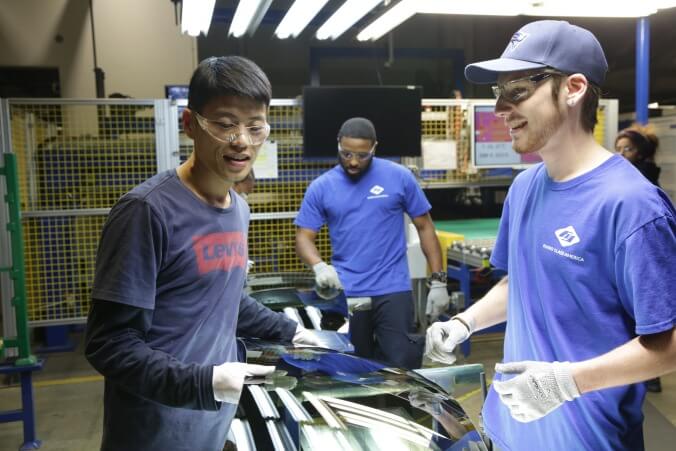There’s no Michael Moore-style agitprop in the superb culture-clash doc American Factory


In 2008, documentarians Steven Bognar and Julia Reichert filmed the final days of an Ohio GM plant for the Oscar-nominated documentary short “The Last Truck.” Nearly a decade later, they returned to the small town of Moraine—just south of Dayton—to film the same facility after it reopened as a glass factory, run by the Chinese manufacturing company Fuyao. The new owners hired mostly locals, putting some experienced unemployed laborers back on the line, side by side with Chinese workers familiar with Fuyao’s processes.
That was the feel-good part of the story, trumpeted by politicians and the local news. Less encouraging? The Americans were being asked to work longer hours than they were used to, for about half the pay, in sometimes hazardous conditions. And they were being told that if they tried to unionize, the plant would be shut down.
Bognar and Reichert’s documentary American Factory covers the disillusionment that sets in over the course of the first few years of Fuyao’s Ohio project. The Chinese are initially excited to embrace the unique qualities and opportunities of the United States. They’re told this is “a place to let your personality run free,” and they enjoy having the freedom to shoot guns and—in theory, at least—to be openly critical of authority. The Americans like learning new skills, being part of a team, and drawing a steady paycheck. But it doesn’t take long for the Fuyao bosses to realize that the Ohio workers will never be as unquestioningly committed to meeting quotas as the Chinese workers. Meanwhile, the Americans are alarmed to find out that the Fuyao executives don’t want to be bothered with reminders about the local environmental and safety regulations.
The filmmakers don’t frame this story in terms of heroes and villains. They don’t take cheap shots at blue collar Americans who vote against their own interests, nor do they paint the Chinese as faceless drones. There’s a matter-of-fact quality, much more reminiscent of Barbara Kopple’s twin labor relations classics Harlan County, U.S.A. and American Dream than Michael Moore’s rabble-rousing agit-prop. American Factory is a detailed, sometimes darkly comic picture of how things are in a manufacturing sector that, two decades into the 21st century, has less and less use for human capital.
American Factory primarily excels in the way it takes all the people involved in this conflict seriously. Bognar and Reichert’s approach is mostly fly-on-the-wall: just hanging back and watching the action in boardrooms and on the factory floor—and, eventually, on the picket lines. They were granted extraordinary access, thanks to public relations representatives who undoubtedly envisioned this film as the happy ending to the story begun by “The Last Truck.” And they earned the trust of their subjects, who frequently turn and address the camera, giving honest assessments of the no-win situations they find themselves in.
What emerges is a study of a possibly unbridgeable cultural divide, where social expectations and the forces of history have shaped very different ideas of what “work” is. There are eerie similarities between the two factions: the Chinese, who have refashioned their old communist party anthems and marches into cheery big business propaganda; and the Americans, who protest outside the plant with union signs and songs that are like relics of a once-thriving institution, long since weakened. But while the Chinese miss their families and cherish their days off as much as their American counterparts do, they’re also conditioned to working 12-hour days, seven days a week.
At one point, one of the shift supervisors from the U.S. side commiserates with a Chinese counterpart, complaining that most of his Ohioans are there to make money, not glass. But as American Factory makes clear, the same is really true for the Chinese as well. It’s just the Chinese will sleep six to an apartment in Dayton, sending most of their paychecks back to the spouses and kids they’re only going to see for about two weeks a year. The native Ohio crew, meanwhile, will make just enough to live on their own (provided that they don’t have any medical mishaps). Everyone—regardless of their background or values—is working hard. By telling their stories, entertainingly and persuasively, Bognar and Reichert make the case that they all deserve better.